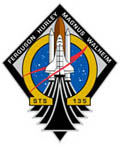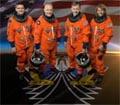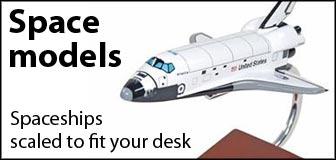 Orbiter: Atlantis Mission: STS-135 Payload: Raffaello Launch: July 8, 2011 Time: 11:26 a.m. EDT Site: Pad 39A, Kennedy Space Center Landing: July 20 @ approx. 7:06 a.m. EDT Site: KSC's Shuttle Landing Facility  
|
Mission Status CenterLive coverage of space shuttle Atlantis' STS-135 mission to the International Space Station. Text updates will appear automatically; there is no need to reload the page. Follow us on Twitter. THURSDAY, JUNE 23, 2011
The Atlantis astronauts followed a realistic countdown sequence today, getting suited up and strapping inside the space shuttle for a thorough dress rehearsal that culminated with a pretend ignition and shutdown of the three main engines at T-minus 4 seconds.
Read our full story. And see the day's photo gallery. 1553 GMT (11:53 a.m. EDT)
The crew just drove by the Press Site.
This will conclude our live play-by-play reports of today's successful countdown dress rehearsal for the space shuttle. The astronauts are scheduled to return to Houston this afternoon to complete their final two weeks of training there. They'll be back in Florida on July 4 to begin the real countdown. Blastoff of the final space shuttle mission remains on target for July 8 at 11:26 a.m. EDT. 1547 GMT (11:47 a.m. EDT)
The Astrovan has departing launch pad 39A to drive Atlantis' astronauts to Kennedy Space Center's crew quarters building.
1546 GMT (11:46 a.m. EDT)
The crew has taken into the elevator from the 195-foot-level of the pad tower down to the ground.
1535 GMT (11:35 a.m. EDT)
The Astrovan is parked at the launch pad to retrieve the crew after they finish things on the tower.
1525 GMT (11:25 a.m. EDT)
All four astronauts have exited Atlantis and headed for the slidewires on the west side of the pad's Fixed Service Structure tower to practice hopping into the baskets while wearing their launch suits and helmets. The crew uses the buddy system in scurrying to the baskets in pairs.
1523 GMT (11:23 a.m. EDT)
A simulated "Mode 1 egress" has been declared. The crew is beginning to crawl out of the shuttle now, all still wearing their helmets with visors down.
1512 GMT (11:12 a.m. EDT)
Once the astronauts complete their post-countdown work, they will climb out the hatch and practice hurrying to the slidewide baskets on the opposite side of the launch tower. These baskets would be used to evacuate the crew to the ground where a fortified bunker awaits. They won't actually ride the baskets today, however.
1509 GMT (11:09 a.m. EDT)
The launch team is completing initial safing of Atlantis and the launch pad following the main engine shutdown rehearsal. The team members are going through the procedures they would use if such a situation happened on launch day. In reality, there have been five such aborts in shuttle history, the most recent in 1994.
1507 GMT (11:07 a.m. EDT)
Today's countdown demonstration has concluded with the simulated ignition and shutdown of Atlantis' three main engines. This is known as a Redundant Set Launch Sequencer abort, indicating the shuttle's onboard computers detected a problem during engine start that forced an emergency stop of the countdown before solid rocket booster ignition.
1505:28 GMT (11:05:28 a.m. EDT)
CUTOFF! The countdown has been halted at T-minus 4 seconds as planned in today's simulation. Safing is in progress to rehearse a pad abort scenario for the space shuttle.
1505:22 GMT (11:05:22 a.m. EDT)
T-minus 10 seconds. "Go" for main engine start.
1505:01 GMT (11:05:01 a.m. EDT)
T-minus 31 seconds. Auto sequence start! The handoff has occurred from the Ground Launch Sequencer to the space shuttle. Atlantis' computers now controlling the final half-minute of the countdown.
1504:32 GMT (11:04:32 a.m. EDT)
T-minus 1 minute. Computers would verify that the main engines are ready for ignition, the sound suppression water system would be armed to activate at T-minus 16 seconds to dampen the sound produced at launch and the residual hydrogen burn ignitors would be armed to fire at T-minus 10 seconds to burn off hydrogen gas from beneath the main engine nozzles.
1504:02 GMT (11:04:02 a.m. EDT)
T-minus 90 seconds.
1503 GMT (11:03 a.m. EDT)
The countdown has resumed after a 35-second hold.
1503 GMT (11:03 a.m. EDT)
T-minus 1 minute, 57 seconds and holding. The launch team has stopped the clock at another of the several milestones available for holding the countdown. Once the count passes this point on launch day, the liquid hydrogen tank is pressurized.
1502 GMT (11:02 a.m. EDT)
T-minus 2 minutes, 15 seconds. The astronauts are being instructed to close and lock the visors on their launch and entry helmets.
1502 GMT (11:02 a.m. EDT)
T-minus 2 minutes, 45 seconds. The external tank liquid oxygen tank pressurization simulation has started.
1501 GMT (11:01 a.m. EDT)
T-minus 3 minutes, 30 seconds. Normally at this point in a real countdown, the aerosurfaces and main engine nozzles of Atlantis would be moved through computer-controlled test patterns to demonstrate their readiness to steer the vehicle during launch. However, none of these activities happen today.
1500 GMT (11:00 a.m. EDT)
T-minus 4 minutes. Activation of the APUs is complete with three units simulated to be up and running. Also, the orbiter's heaters have been configured for launch by commander Chris Ferguson.
The final helium purge sequence is underway in the main propulsion system. This procedure readies fuel system valves for engine start. 1459 GMT (10:59 a.m. EDT)
T-minus 5 minutes and counting again after a 38-second hold. The "go" has been given for the simulated Auxiliary Power Unit start. Pilot Doug Hurley would flip three switches in Atlantis' cockpit to start each of the three APU's. The units, located in the aft compartment of Atlantis, provide the pressure needed to power the hydraulic systems of the shuttle. The units will be used during the launch and landing phases of the mission for such events are moving the orbiter's aerosurfaces, gimbaling the main engine nozzles and deploying the landing gear.
1459 GMT (10:59 a.m. EDT)
T-minus 5 minutes and holding. The clock has stopped briefly as part of the demonstration test. This is an available hold point in the space shuttle countdown prior to starting the Auxiliary Power Units.
1458 GMT (10:58 a.m. EDT)
T-minus 6 minutes. Pilot Doug Hurley has been asked by Orbiter Test Conductor to simulate pre-starting the orbiter Auxiliary Power Units. This procedure readies the three APU's for their activation after the countdown passes T-minus 5 minutes.
1456 GMT (10:56 a.m. EDT)
T-minus 7 minutes, 30 seconds. The Ground Launch Sequencer is simulating retraction of the Orbiter Access Arm from the crew hatch on the the vehicle. The arm was the passage way for the astronauts to board Atlantis earlier this morning.
1455 GMT (10:55 a.m. EDT)
T-minus 9 minutes and counting. The Ground Launch Sequencer is now controlling the final phase of today's countdown to the pretend launch of space shuttle Atlantis at 11:04:19 a.m. EDT.
1451 GMT (10:51 a.m. EDT)
The countdown will resume shortly as the launch team finishes simulating activities during the T-minus 9 minute hold.
1446 GMT (10:46 a.m. EDT)
Now half-way through this planned hold. Final readiness polls are coming up. It is a beautiful morning at the Florida spaceport and all weather rules are "go" for launch today.
1441 GMT (10:41 a.m. EDT)
T-minus 9 minutes and holding. The next pause point in the countdown has been reached. This hold is scheduled to last 10 minutes.
In the past few minutes, commander Chris Ferguson enabled the abort steering instrumentation while pilot Doug Hurley configured the displays inside Atlantis' cockpit for launch. Hurley also simulated reconfiguring the main propulsion helium system. 1430 GMT (10:30 a.m. EDT)
T-minus 20 minutes and counting. Clocks are running again and headed down to the T-minus 9 minute mark where the next hold is scheduled.
1420 GMT (10:20 a.m. EDT)
T-minus 20 minutes and holding. Countdown clocks have gone into the planned 10-minute hold. Today's simulated launch remains set for 11:00 a.m. EDT.
1415 GMT (10:15 a.m. EDT)
Powering space shuttle Atlantis throughout its eight-and-a-half minute climb to orbit will be the three main engines built by Pratt & Whitney Rocketdyne. The cryogenic powerplants are fed with liquid hydrogen and liquid oxygen stored in the external fuel tank.
In the engine No. 1 position today is the Block 2-2047 engine now making its 14th launch. STS-91 was its debut flight on Endeavour to the Russian space station Mir and STS-132 was the most recent aboard Atlantis to the International Space Station. Making its third launch is the Block 2-2060 in the engine No. 2 position. The previous flights included Endeavour's STS-127 and Discovery's STS-131 mission to the International Space Station. And Block 2-2045 is engine No. 3 on Atlantis. This powerplant is flying for the 12th time starting with Endeavour's STS-89 to Mir and most recently on Discovery's STS-131. 1410 GMT (10:10 a.m. EDT)
Commander Chris Ferguson is simulating pressurization of the gaseous nitrogen system for Atlantis' Orbital Maneuvering System engines while pilot Doug Hurley goes through the steps to activate the gaseous nitrogen supply for the orbiter's Auxiliary Power Units' water spray boilers.
1400 GMT (10:00 a.m. EDT)
The reusable solid rocket boosters, built by ATK, provide the primary thrust to propel the space shuttle away from Earth during the initial two minutes of flight. The 11 sections on each booster flying on Atlantis are a mixture of refurbished and brand new hardware. The upper cylinder on the left booster, for example, flew on the original shuttle mission in 1981 and now flies on the final one. The forward dome on the left-hand booster is flying for the very first time.
In all, Atlantis' twin boosters have reused segments and pieces that trace back to 59 previous shuttle launches and 12 ground test-firings. Detailed history information about Atlantis' two boosters can be seen in this PDF download here. The boosters will parachute into the Atlantic Ocean where a pair of retrieval ships are standing by to recover the rockets and tow them back to shore. 1340 GMT (9:40 a.m. EDT)
T-minus 1 hour and counting. The orbiter closeout crew has finished the hatch closure test and reopened it.
1328 GMT (9:28 a.m. EDT)
With all of the astronauts inside the spacecraft, the launch pad crew is shutting the crew module hatch to run through those procedures for practice.
1320 GMT (9:20 a.m. EDT)
A reminder that if you will be away from your computer but would like to receive occasional countdown updates, sign up for our Twitter feed to get text messages on your cellphone. U.S. readers can also sign up from their phone by texting "follow spaceflightnow" to 40404. (Standard text messaging charges apply.)
And check out Spaceflight Now's Facebook page! 1300 GMT (9:00 a.m. EDT)
The final Atlantis astronaut has boarded the shuttle today. Rex Walheim just entered the hatch to sit on the flight deck's aft-center seat as mission specialist No. 2 and flight engineer.
The 48-year-old California native, a retired Air Force colonel, has flown aboard shuttle Atlantis twice before. Walheim's first spaceflight in 2002 on the STS-110 mission installed the center section of the International Space Station's truss backbone. Then came STS-122 in 2008 that brought the European Space Agency's Columbus science laboratory to the station. Read his NASA biography here and Spaceflight Now+Plus subscribers can watch an extended pre-launch interview. 1242 GMT (8:42 a.m. EDT)
Astronaut Sandy Magnus, a native of Belleville, Illinois, is ingressing the flight deck's aft-right seat as Atlantis' mission specialist No. 1 to launch aboard the space shuttle for the third time.
NASA selected Magnus, who has a doctorate in material science, as an astronaut in 1996 and she flew as a rookie aboard shuttle Atlantis' STS-112 mission in 2002 that installed the Starboard 1 truss on the International Space Station. Then came assignment as an Expedition 18 flight engineer and science officer aboard the station, launching with Ferguson aboard Endeavour's STS-126 and spending four-and-a-half months living on the outpost before returning to Earth on Discovery's STS-119 mission in 2009. Read her NASA biography here and Spaceflight Now+Plus subscribers can watch an extended pre-launch interview. 1240 GMT (8:40 a.m. EDT)
Now passing the T-minus 2 hour mark in the countdown. A pair of 10-minute built-in holds are planned at T-minus 20 minutes and T-minus 9 minutes, leading toward the 11:00 a.m. T-0 time.
1226 GMT (8:26 a.m. EDT)
Atlantis pilot Doug Hurley is making his way to the flight deck's front-right seat right now.
Born in Upstate New York, his interests in engineering and flying led Hurley on a path to becoming an astronaut. The 44-year-old colonel from the Marine Corps previously flew for 16 days aboard shuttle Endeavour's STS-127 mission in 2009 that delivered the final piece of Japan's scientific facilities at the International Space Station. Read his NASA biography here and Spaceflight Now+Plus subscribers can watch an extended pre-launch interview. 1213 GMT (8:13 a.m. EDT)
Commander Chris Ferguson, a 49-year-old retired Navy captain born in Philadelphia, is the first astronaut to board the shuttle today, taking the forward-left seat on the flight deck.
This will be his third spaceflight after serving as pilot on Atlantis' STS-115 mission in 2006 that installed another solar power truss on the International Space Station and commander of Endeavour's STS-126 mission in 2008 that brought up critical equipment to remodel the outpost's interior in preparation for doubling the size of its resident crews. Read his NASA biography here and Spaceflight Now+Plus subscribers can watch an extended pre-launch interview. 1201 GMT (8:01 a.m. EDT)
The astronauts have arrived at launch pad 39A to start climbing aboard the space shuttle Atlantis. After getting off the Astrovan, the crew took an elevator up to the 195-foot-level of the tower to reach the orbiter access arm that swings over to Atlantis' hatch.
1155 GMT (7:55 a.m. EDT)
There goes the astronauts! The crew just drove by the Press Site on their way from Kennedy Space Center's crew quarters building to the launch pad in the shiny silver Astrovan.
1147 GMT (7:47 a.m. EDT)
HERE COMES THE CREW. Space shuttle Atlantis' four veteran astronauts have departed Kennedy Space Center's crew quarters building for this morning's countdown dress rehearsal.
Commander Chris Ferguson, pilot Doug Hurley and mission specialists Sandy Magnus and Rex Walheim are heading to launch pad 39A where they will climb aboard the orbiter today. 1140 GMT (7:40 a.m. EDT)
T-minus 3 hours and counting. Clocks have resumed ticking for the Terminal Countdown Demonstration Testing, still targeting an 11:00 a.m. EDT pretend liftoff time for Atlantis this morning.
1125 GMT (7:25 a.m. EDT)
T-minus 3 hours and holding. The countdown is nearing the end of this scheduled built-in hold that started at 5 a.m. EDT. On the real shuttle launch day, fueling of Atlantis will be long finished by this point in the count.
But following through with the sequence for this morning's dress rehearsal, the orbiter closeout crew is working pad 39A to ready Atlantis for the astronauts' arrival. The team has been busy inside Atlantis' cockpit configuring switches and verifying systems with the launch control center. The closeout team will assist the astronauts getting strapped into their seats just like launch day. 1030 GMT (6:30 a.m. EDT)
It's practice launch day for the shuttle Atlantis, her four-person astronaut crew and the various ground teams supporting the spacecraft's ascent to orbit. Even the news media joins in the action by photographing the astronauts departing their quarters and following along with the countdown today.
The astronauts were awakened in their quarters earlier this morning to have breakfast and begin donning their day-glow orange pressure spacesuits worn during the ascent and entry phases of a shuttle mission. We'll expect to see the crew emerge around 7:45 a.m. and then head for the launch pad in the Astrovan. All activities remain on track for the simulated launch time of 11 a.m. WEDNESDAY, JUNE 22, 2011
Engineers carrying out X-ray inspections of 50 rib-like "stringers" in the shuttle Atlantis' external tank are running ahead of schedule and so far, officials said Wednesday, there are no signs of any temperature-induced cracks in the wake of a fueling test last week.
Working in parallel, another team replaced a leaking hydrogen valve in main engine No. 3 on Tuesday. Reassembly and closeout should be complete by this weekend, clearing the way for tests to make sure the valve is leak free and working properly for launch July 8. Read our full story. 1315 GMT (9:15 a.m. EDT)
Countdown clocks around Complex 39 have started ticking for tomorrow's launch day dress rehearsal by the space shuttle Atlantis astronauts to culminate the week's exercises at Kennedy Space Center.
"We always enjoy getting down to Kennedy Space Center, seeing the hardware and we're really looking forward to tomorrow to simulate the countdown," pilot Doug Hurley told reporters at pad 39A this morning. "You're working with the whole team down here and actually going through a launch count right up until T-0. You've got your suits, you're suit techs, you're doing all the motions you go through on launch day all the way out to the pad." The Terminal Countdown Demonstration Test underway at the Florida spaceport has put the crew through emergency procedure drills and given commander Chris Ferguson and Hurley some time to practice landing approaches in the Shuttle Training Aircraft. The astronauts will train on the launch pad tower today and also visit the orbiter's payload bay for an up-close tour. In the Launch Control Center, the clocks began counting down this morning at 8 a.m. EDT as the TCDT builds toward the simulated launch Thursday. We will provide live updates right here on this page as the crew heads for the launch pad and gets strapped aboard Atlantis for the final three hours of the countdown that targets a mock 11 a.m. liftoff time. Meanwhile, technicians have finished the X-ray inspections of the liquid oxygen-side of the external tank support beams. The survey equipment has been reconfigured to begin checking the lower liquid hydrogen-side of the intertank. And the new fuel valve has been installed into Atlantis' main engine No. 3. That work was completed yesterday. The retesting activities are still to come. TUESDAY, JUNE 21, 2011
Space shuttle officials met today for their program-level readiness review to assess the status of systems and preparations to launch Atlantis. The meeting concluded with a unanimous "go" to press onward to the agency-level Flight Readiness Review next Tuesday that formally establishes the launch date.
At pad 39A today, technicians worked to remove and replace the suspect main fuel valve from Atlantis' right-hand engine that leaked during last week's tanking test. A follow-up helium leak check will be performed on the engine later this week. The external tank digital X-rays continue to be gathered as well. NASA says no problems have been found thus far. And the astronauts are well into their emergency training activities at Kennedy Space Center. They took turns test-driving an armored tank around Complex 39 this morning to familiarize themselves with the vehicle in the fields adjacent to the launch site. The tank would be used by the crew to escape the pad 39A bunker in a dire scenario during the space shuttle countdown. See our photo gallery. They will have a press conference at the launch pad Wednesday morning around 8:40 a.m. EDT. We'll stream it live right here on this page. MONDAY, JUNE 20, 2011
The four astronauts to fly Atlantis on the final space shuttle voyage have jetted into the Kennedy Space Center for this week's countdown dress rehearsal and emergency training drills.
Read our full story. 2355 GMT (7:55 p.m. EDT)
Inside the cleanrooom at Kennedy Space Center's launch pad 39A, the ground-handling mechanism inserts the Italian-made Raffaello cargo module and the aft carrier structure into space shuttle Atlantis' payload bay.
See a photo gallery. 2140 GMT (5:40 p.m. EDT)
"It's great to be out here," commander Chris Ferguson says. "We're just trying to savor the moment."
Check back in a little while for a story and some photos. 2137 GMT (5:37 p.m. EDT)
Shuttle launch director Mike Leinbach and Atlantis flow director Angie Brewer are on hand to greet the astronauts.
2133 GMT (5:33 p.m. EDT)
Space shuttle Atlantis' four astronauts have touched down in their T-38 training jets to begin this week's Terminal Countdown Demonstration Test at the Florida spaceport. Live video of the crew's comments is coming up.
2128 GMT (5:28 p.m. EDT)
Good day from the Shuttle Landing Facility where reporters and photographers have gathered to cover the astronauts' arrival a short time from now.
2050 GMT (4:50 p.m. EDT)
Arrival time has moved up to approximately 5:35 p.m. EDT.
2020 GMT (4:20 p.m. EDT)
The astronauts have stopped for refueling in Mobile, Alabama. NASA still projects the crew will arrive at Kennedy Space Center around 5:45 p.m. EDT.
1905 GMT (3:05 p.m. EDT)
Atlantis' crew is traveling from Ellington Field outside Houston's Johnson Space Center for today's trip over to Florida's Kennedy Space Center. Arrival out at the Shuttle Landing Facility runway is anticipated beginning around 5:45 p.m. EDT.
The astronauts are flying in two T-38 jets:
1530 GMT (11:30 a.m. EDT)
Space shuttle Atlantis' astronauts will be welcomed to the Kennedy Space Center this afternoon to begin the Terminal Countdown Demonstration Test activities. TCDT week includes emergency training drills and a launch day dress rehearsal for the crew.
Arrival at the spaceport runway is expected around 5:45 p.m. EDT. We'll provide live streaming video of the event, which will feature some comments by the crew. Meanwhile, the X-ray scanning of the external fuel tank's strengthened ribbed support beams began yesterday and will continue through the week. These inspections will give NASA confidence that no cracks formed during last week's fueling test. And Atlantis' aft compartment has been opened up and preparatory steps are underway to remove and replace the leaky main fuel valve on space shuttle main engine No. 3. Aboard the International Space Station, the European Automated Transfer Vehicle named "Johannes Kepler" undocked at 10:46 a.m. EDT today following its successful cargo resupply and altitude reboost mission to the outpost. The freighter will be deorbited into the ocean on Tuesday. Expedition 28 crewmates Ron Garan and Mike Fossum are working inside the Quest airlock module today prepping the spacesuits they will wear during the one spacewalk planned on Atlantis' mission. The veteran astronauts will go outside to transfer a robotic refueling experiment from the shuttle and relocate a failed ammonia coolant pump to Atlantis for return to Earth. SUNDAY, JUNE 19, 2011
A cargo-laden module stuffed with a full year's worth of necessities for the International Space Station will be loaded into shuttle Atlantis' payload bay Monday to prepare for launch next month.
Read our full story. SATURDAY, JUNE 18, 2011
The launch pad's mobile gantry, with the mission payloads safely tucked inside its cleanroom, was rotated to enclose space shuttle Atlantis this morning at about 5:30 a.m. EDT. Raffaello had been offloaded from the transporter to the ground handling mechanism inside the tower on Friday and the canister lowered away early today.
The gantry will remain around Atlantis from now until 2 p.m. the afternoon before launch when it retracts to reveal the shuttle for the final countdown. Meanwhile, the X-ray inspections will begin tonight on the external tank to ensure the strengthening modifications worked as expected during the recent fueling test. These checks to the orbiter-side of the tank's ribbed midsection should take several days to complete. A large crane has been brought to the pad for lifting the inspection equipment up to the gantry roof this afternoon. Also, access platforms have been set up inside the tank's intertank compartment from the doorway on backside of the shuttle. Work to replace the main fuel valve on space shuttle main engine No. 3 is scheduled to start Monday. Also next week, the practice countdown and emergency training for the astronauts will be ongoing. FRIDAY, JUNE 17, 2011
The transporter shaped like the shuttle's 60-foot-long payload bay and possessing the Raffaello cargo-delivery module and a robotic refueling experiment for the International Space Station was hoisted into launch pad 39A overnight.
1145 GMT (7:45 a.m. EDT) Work to unload the payloads onto the handling mechanism inside the pad's cleanroom will be underway today and the canister should be lowered away tonight, allowing the service tower to roll back around Atlantis early tomorrow morning. Once all of that is completed, the orbiter's payload bay doors can be opened and these final pieces of space shuttle cargo will be tucked inside Atlantis for launch. 0325 GMT (11:25 p.m. EDT Thurs.)
The special transport canister holding the 30,000 pounds of payloads for shuttle Atlantis has climbed up the ramp to the pad surface and over to the gantry. Technicians plan to start the canister lifting operations after 12:30 a.m.
0305 GMT (11:05 p.m. EDT Thurs.)
The payload convoy is entering through the launch pad's perimeter gate now.
0130 GMT (9:30 p.m. EDT Thurs.)
The payload's drive to launch pad 39A is underway right now. The canister should reach the complex in a couple of hours, then get lifted into the gantry overnight.
Previously, the transporter left the Space Station Processing Facility on Monday and was taken to the special building where Tuesday it was turned vertically to stand upright. The journey to pad 39A began with the team reporting for duty this evening at 8:30 p.m. Read our earlier status center coverage. |
Upcoming mission events:
Space video for your computer, iPod or big screen TV
Experience the space program like never before become a subscriber today |


